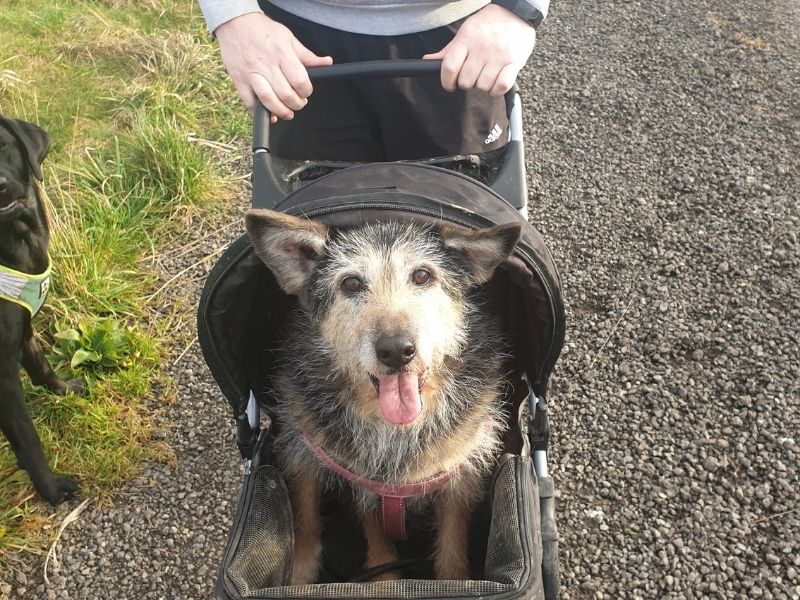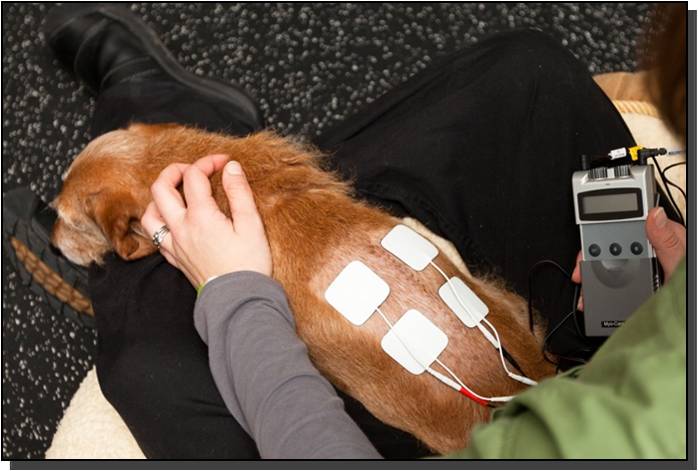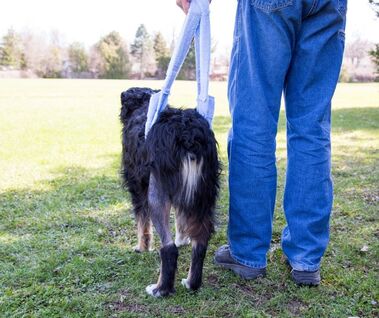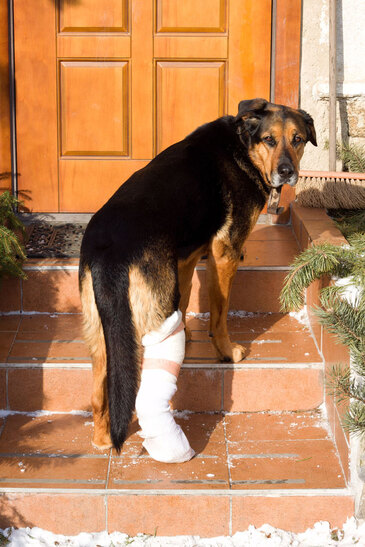
Degenerative myelopathy, also known as DM, is a tough diagnosis for any pet parent. There is no known cure and it causes significant mobility issues eventually leading to paralysis. However, there are things you can do to help improve and maintain your dog’s quality of life for a period of time. Here is what you need to know about degenerative myelopathy, and what you can do to help your dog.
What is Degenerative Myelopathy?
Degenerative myelopathy is a rare disease and the exact cause is unknown, but there appears to be a genetic component. It affects the spinal cord, causing progressive hind limb weakness and eventually, paralysis. It’s similar to a condition in humans called amyotrophic lateral sclerosis (ALS), also known as Lou Gehrig’s Disease.
In its early stages, clinical signs of DM may appear similar to osteoarthritis, which can complicate diagnosing this condition. Dogs with DM generally have normal bladder and bowel function in the beginning, as well. As the disease progresses, dogs have weakness and ataxia, or stumbling and wobbling, and they may develop urinary and fecal incontinence as paralysis sets in. Dogs generally don’t appear to have pain, only weakness.
A gene mutation is suspected as a possible cause, though scientists don’t know for sure. It’s believed that dogs with two copies of the mutated SOD-1 gene can develop DM, however, not all dogs do. With DM, the nervous system pathways in the spinal cord are disrupted so the brain can’t communicate with the limbs to signal them to work properly.
Signs of Degenerative Myelopathy
There are a number of signs for DM that will progress as the condition worsens. Here are some of the early signs to look for:
As the condition progresses, these signs worsen. DM eventually leads to hind-end paralysis where the dog is completely unable to use his hind legs. Ultimately, the condition will progress to the front legs, and finally to the muscles involved in breathing.
Is My Dog at Risk?
Unfortunately, there’s really no way of knowing for certain if your dog is at risk. There is a genetic mutation, SOD-1, which has been identified as a risk factor for DM. Dogs can be tested for this gene, but as mentioned, just because a dog has this anomaly doesn’t mean they will develop the disease. This DNA test is readily available and easy to do, however.
Certain breeds may be more prone to it including German Shepherds, Siberian Huskies, Collies, Boxers, Poodles and miniature Poodles, Corgis, Ridgebacks, and some others. But the truth is that they have found a correlation but not a cause.
DM is most common in middle-aged to older dogs with the average age of onset being 8 years of age, but ranging from 4 to 14 years of age. Though, occasionally it has been diagnosed in younger dogs.
How is DM Diagnosed?
Your veterinarian will review the medical history, do a physical exam, and run diagnostic tests like X-rays and others to rule out other joint issues like hip dysplasia and osteoarthritis. It’s not easy to definitively diagnose as histopathology of the spinal cord is required. So, it’s a process of testing and ruling things out to determine the diagnosis. Your veterinarian may also refer you to a veterinary neurologist for further testing.
A neurologist may also run some tests including tissue biopsies, neuromuscular tests, cerebrospinal fluid analysis (CSF), or an MRI. For any dog that is an at-risk breed and displaying symptoms consistent with DM, a DNA test to check for the gene mutation is also recommended. Though it’s not a definitive diagnosis, it does show a likelihood that gets factored in with diagnosing this condition.
How is Degenerative Myelopathy Treated?
Degenerative Myelopathy is a progressive disease with no cure. Treatment is about managing concurrent medical issues like arthritis to provide pain relief and maintaining an ideal weight. Targeted exercise is important to maintain muscle mass, strength, and balance for as long as possible. The goal is to slow down the progression of the condition allowing your dog to retain function and mobility as long as possible. Consistent and aggressive physical rehabilitation has been shown to slow the disease down and extend your dog’s life, while also improving quality of life.
A variety of mobility assistive devices are commonly utilized to facilitate movement and allow as much independence as possible, for as long as possible, through the various stages of DM. A cart, or “doggie wheelchair” can help improve a dog’s quality of life when the disease advances. With the right care and guidance, many dogs with DM can enjoy a very good quality of life even in this stage of the disease.
What Should I Do if I Suspect My Dog Has DM
If you think your dog may have DM, make an appointment with your primary vet right away. It does take some time to run the tests to rule other issues out. If your vet does believe your dog has DM, please consider physical rehabilitation as soon as possible. The sooner we start building and maintaining your dog’s muscle mass, the better they will be for longer.
What is Degenerative Myelopathy?
Degenerative myelopathy is a rare disease and the exact cause is unknown, but there appears to be a genetic component. It affects the spinal cord, causing progressive hind limb weakness and eventually, paralysis. It’s similar to a condition in humans called amyotrophic lateral sclerosis (ALS), also known as Lou Gehrig’s Disease.
In its early stages, clinical signs of DM may appear similar to osteoarthritis, which can complicate diagnosing this condition. Dogs with DM generally have normal bladder and bowel function in the beginning, as well. As the disease progresses, dogs have weakness and ataxia, or stumbling and wobbling, and they may develop urinary and fecal incontinence as paralysis sets in. Dogs generally don’t appear to have pain, only weakness.
A gene mutation is suspected as a possible cause, though scientists don’t know for sure. It’s believed that dogs with two copies of the mutated SOD-1 gene can develop DM, however, not all dogs do. With DM, the nervous system pathways in the spinal cord are disrupted so the brain can’t communicate with the limbs to signal them to work properly.
Signs of Degenerative Myelopathy
There are a number of signs for DM that will progress as the condition worsens. Here are some of the early signs to look for:
- Your dog’s hindquarters seem to sway when standing.
- Uncoordinated gait. DM often starts with one rear leg and moves to the other.
- Collapsing easily when pushed from the side.
- Hind paws turn under (knuckle) so the dog walks on its knuckles.
- Hind feet scrape the ground when walking. You may notice the tops of the toes lose hair from this happening continuously. The nails on the hind feet may wear down excessively too.
- Your dog has difficulty getting up from lying down.
- Loss of muscles in the hind legs.
As the condition progresses, these signs worsen. DM eventually leads to hind-end paralysis where the dog is completely unable to use his hind legs. Ultimately, the condition will progress to the front legs, and finally to the muscles involved in breathing.
Is My Dog at Risk?
Unfortunately, there’s really no way of knowing for certain if your dog is at risk. There is a genetic mutation, SOD-1, which has been identified as a risk factor for DM. Dogs can be tested for this gene, but as mentioned, just because a dog has this anomaly doesn’t mean they will develop the disease. This DNA test is readily available and easy to do, however.
Certain breeds may be more prone to it including German Shepherds, Siberian Huskies, Collies, Boxers, Poodles and miniature Poodles, Corgis, Ridgebacks, and some others. But the truth is that they have found a correlation but not a cause.
DM is most common in middle-aged to older dogs with the average age of onset being 8 years of age, but ranging from 4 to 14 years of age. Though, occasionally it has been diagnosed in younger dogs.
How is DM Diagnosed?
Your veterinarian will review the medical history, do a physical exam, and run diagnostic tests like X-rays and others to rule out other joint issues like hip dysplasia and osteoarthritis. It’s not easy to definitively diagnose as histopathology of the spinal cord is required. So, it’s a process of testing and ruling things out to determine the diagnosis. Your veterinarian may also refer you to a veterinary neurologist for further testing.
A neurologist may also run some tests including tissue biopsies, neuromuscular tests, cerebrospinal fluid analysis (CSF), or an MRI. For any dog that is an at-risk breed and displaying symptoms consistent with DM, a DNA test to check for the gene mutation is also recommended. Though it’s not a definitive diagnosis, it does show a likelihood that gets factored in with diagnosing this condition.
How is Degenerative Myelopathy Treated?
Degenerative Myelopathy is a progressive disease with no cure. Treatment is about managing concurrent medical issues like arthritis to provide pain relief and maintaining an ideal weight. Targeted exercise is important to maintain muscle mass, strength, and balance for as long as possible. The goal is to slow down the progression of the condition allowing your dog to retain function and mobility as long as possible. Consistent and aggressive physical rehabilitation has been shown to slow the disease down and extend your dog’s life, while also improving quality of life.
A variety of mobility assistive devices are commonly utilized to facilitate movement and allow as much independence as possible, for as long as possible, through the various stages of DM. A cart, or “doggie wheelchair” can help improve a dog’s quality of life when the disease advances. With the right care and guidance, many dogs with DM can enjoy a very good quality of life even in this stage of the disease.
What Should I Do if I Suspect My Dog Has DM
If you think your dog may have DM, make an appointment with your primary vet right away. It does take some time to run the tests to rule other issues out. If your vet does believe your dog has DM, please consider physical rehabilitation as soon as possible. The sooner we start building and maintaining your dog’s muscle mass, the better they will be for longer.








 RSS Feed
RSS Feed